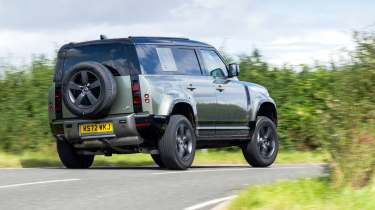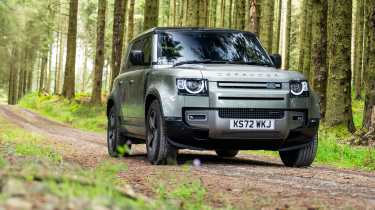Land Rover Defender 110 Fast Fleet test – 9000 miles in the go-anywhere SUV
After three months on test, the new Defender has demonstrated how it slots neatly into an ‘evo‘ lifestyle
The latest Land Rover Defender is a machine that means business – that’s something that has become very clear to me after covering 9000 miles in the D300 X-Dynamic HSE model that evo ran through the summer. Whether that business is conquering the urban jungle or venturing off the beaten path, or a combination of both, is up to you.
For the former role, KS72 WKJ came well equipped. Outside, the rugged looks were offset by the striking gloss finish to the Pangea Green metallic paint (a £895 extra), while inside, despite the purposeful vibe, there were plenty of creature comforts to be found. The Khaki seats, finished in Land Rover’s durable but soft ‘Resist’ material, were 14-way adjustable, with electric memory and a cooling function too, and they proved brilliantly comfortable on long drives. The sliding panoramic glass roof let lots of extra light into the cabin but also came into its own when I wanted to capture high-up car-to-car shots while out on a photoshoot. And the 14-speaker Meridian Surround Sound System (£630) filled the large cabin with music with ease, and was accompanied by an 11.4-inch touchscreen that was a tech lover’s dream – responsive, packed with features, and a pleasure to use.
More reviews
In-depth reviews
Reviews
- Land Rover Defender Octa 2025 review – so much more than a ‘Defender SV’
- Land Rover Classic Defender V8 2024 review – driving a £190,000 Land Rover
- Land Rover Defender 130 V8 2024 review – an exercise in excess
- Bowler Defender 2023 review
- Bowler Defender Challenge 2022 review – the ultimate off-road toy?
- Land Rover Defender V8 2021 review – a G63 rival, or something more subtle?
- Land Rover Defender 90 X P400 2020 review – heart over head
> Land Rover Classic Defender V8 2024 review – driving a £190,000 Land Rover
But this Defender isn’t just about style and comfort: it’s built to tackle any terrain. As such there are a host of off-road modes in the Terrain Response system that enable it to adapt to whatever environment it is travelling through. I was disappointed I didn’t get the chance to put the wading mode to the test – it lifts the car on its air suspension and enables it to tackle water depths of up to 90cm, with sensors to warn you when you’re approaching that limit – but I did manage to get WKJ away from the asphalt on a few occasions and found it very capable (and comfortable) across dirt and gravel. It was also incredibly useful not having to seek out a lay-by to park up in each time I needed to hop out with my camera on shoots; simply drive up onto the nearest verge and – hey presto! – you have a parking spot.
The tall, 60-profile sidewalls of the Pirelli Scorpion Zero tyres meant the 20-inch Satin Dark Grey wheels (£502) were never at risk of being damaged during such excursions like the larger rims of a more road-biased SUV might. The Defender is definitely more of an off-road SUV than a sports SUV, but nevertheless it feels stable and confidence-inspiring when driven with enthusiasm on the road. It’s no slouch in D300 spec, either, thanks to a 3-litre six-cylinder twin-turbocharged mild-hybrid diesel engine, which develops 296bhp and 479lb ft of torque and is mated to an eight-speed automatic transmission, giving a 0-62mph time of just 6.6sec and a top speed of 119mph.
The 89-litre fuel tank ensures you can go the distance, too. On one occasion we drove from the UK down to Paris and then back up to Bruges on a single tank – well over 400 miles. Driving through the A86 Duplex Tunnel in Paris highlighted that the Defender’s large size is always something to keep in mind, however: the 10km tunnel, designed specifically for light vehicles (I hope the 2361kg Defender qualified…), has a height limit of 2 metres, while the 110 sits at 1.97 metres tall. That was a tense couple of minutes…
Despite the car’s size, parking and manoeuvring were always a breeze thanks to the 3D Surround Camera system, which gives you a 360-degree overhead view in real time. Another useful feature was the Land Rover Remote phone app, which enables you to connect to the car remotely to do things such as check its fuel level, track your journeys, or – best of all – pre-heat the cabin before setting off in the early hours of the morning.
One thing I didn’t get on with on the Defender was its boot. Admittedly, it’s perhaps not such a big deal if you’re not an automotive photographer who spends a fair amount of his time hanging out of car boots shooting the car that’s following behind, but because the Defender’s rear door opens sideways rather than upwards, it ruled out this kind of tracking shot, because the door would always have been in the image. In more typical use it still needed more free space behind the car than a conventional tailgate requires, which could make it restrictive in some car park situations. In addition, the load area felt really cheap, and the heavy-duty hard-plastic floor meant everything placed upon it would skid across the car in every turn. To top it off, the load-area cover to keep your stuff out of sight seemed to have been made out of a towel with some elastic bands to keep it in place, and these were constantly popping off.
But these quibbles aside, I really enjoyed running the Defender. It’s classy, stylish and practical all at once, a versatile and formidable machine ready for whatever challenge you want to throw at it. Now over to our editor-in-chief for a second opinion. – Aston Parrott
It won’t have escaped your attention that the new (is a car launched in 2019 still considered new?) Defender has been a bit of a hit for the rebranded JLR, with 74,881 examples delivered in the last year and little sign of the numbers softening anytime soon. Spending time in the 110 that evo has been testing over the last few months provided plenty of evidence as to why it’s proving to be such a hit.
At its core is how it drives. Not the ‘reaching the outer limits of grip as the granular detail of its steering feel bristles through your fingertips’ type of driving, but the kind of driving for which the Defender has been designed. It’s reassuring in all situations bar trying to navigate a small English village, is relaxing to be in, and has you re-evaluating what you think of cars that weigh too much and occupy too much road space. Loaded with kit and people and with a few hundred miles ahead of you, the Defender is a refined refuge in which to complete such a trip. A car costing £81,075 (£73,130 before options) should of course be exemplary in all that it does, but the Defender went above and beyond our expectations in many areas.
Based on the group’s D7 platform that underpins the Discovery 5, the Defender adds an ‘X’ to that designation, for ‘Extreme’. But this comes at no expense to its on-road behaviour – it’s as prepared to tackle the wilderness in air-conditioned comfort as it is the UK’s roads and every pothole and crumbling surface they can throw at its 20-inch wheels. There’s nothing that phases it or disrupts those onboard. It does the simple things right and some other things incredibly well.
In an evo world a car such as the Defender isn’t a first-choice purchase based on a lifetime’s longing. It’s a car bought through necessity, one to throw a lifestyle at day to day and turn to when your toy needs towing somewhere exciting (or to be repaired). Hook up a loaded covered trailer (in my case with an Escort Cosworth inside) and the Ingenium 3-litre straight-six doesn’t even know it’s there. For infrequent towers it takes a lot of the sweat out of the process, but if you’re considering the 90 variant be mindful that its shorter wheelbase can be a little snappy when towing (its smaller boot space and compromised access to the back seats isn’t great either), while the longer body of the 130 will increase the possibility of a trailer trying to wag the car. Friends who use Defenders to tow regularly and for a living are firmly in the 110 camp when it comes to this discipline.
So far, so expected of a Land Rover product. So what? It’s designed to be practical, dependable, rugged and an automotive multi-tool. Of course it should be good at all this stuff. But it’s how the Defender feels like a normal car that creates the platform for its sales success. You don’t need to work around or make excuses for any foibles because it has so few, certainly fewer than most cars. The sizeable area required to fully open its tailgate is a rare big issue.
You might feel a fraud for opting for a Defender when an estate car would probably do for 95 per cent of your requirements if space is really your only criterion, but that high-set driving position is welcome when the summer sun comes up and you can spot Bambi from afar, ambling home from her nighttime manoeuvres without a care in the world or any sense that a 2.3-ton SUV is on the same piece of tarmac she is about to step onto.
Fitted with all-season tyres and equipped with a chassis designed in the first instance to crawl through a bog means there’s more tyre noise than you’ll experience in a more regular premium SUV. And while the torque-rich diesel motor can press on, physics will always come out on top when you’re really pushing it. But then you’d have to be a little strange if you thought a Defender was going to ignite your inner McRae.
The Defender’s success has not only given rivals something to think about, internally at JLR it’s heaped more pressure on the similarly priced Discovery 5, which despite sharing the same platform, being more refined and luxurious, and being built in the same Slovakian factory, has sales and a level of popularity that are very much in the Defender’s shadow. The Disco drives better on the road but the Defender looks better on it in the eyes of the majority – especially from the rear, an angle from which the Disco 5 isn’t easy to stomach.
If our brief time with this reimagined icon has taught us anything it’s that while cars this heavy and this big are increasingly hard to justify, especially so in an automotive landscape that’s pushing for maximum efficiency and environmental responsibility, if you need (or want) something that can do literally everything your weekend car can’t, the Defender is the most fit-for-purpose device possible.
| Date acquired | October 2023 |
| Duration of test | 3 months |
| Total test mileage | 9298 |
| Overall mpg | 29.0 |
| Total costs | £0 |
| Purchase price | £81,075 |
| Value today | c£70,000 |
This story was first featured in evo issue 317.








